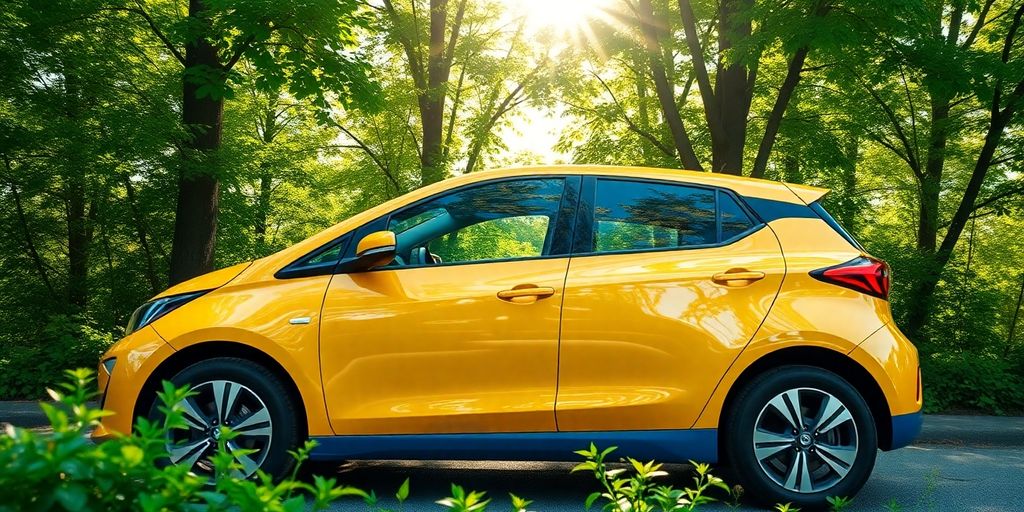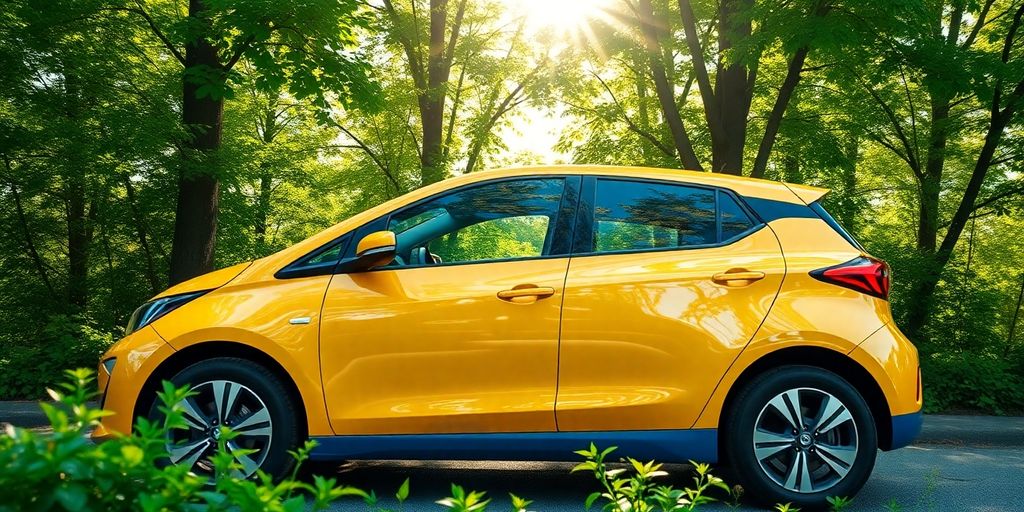Batteries Beyond Lithium: The Future of Electric Cars

Electric cars have been all the rage, but the batteries that power them? Not so much. Everyone’s heard of lithium-ion batteries, but what if we could use something else? There’s a whole world of materials out there that could change the game. From sodium to magnesium, the possibilities are endless. But can we really make electric car batteries without lithium? Let’s find out.
Key Takeaways
- Sodium-ion batteries are gaining attention as a cheaper and more abundant alternative to lithium-ion.
- Solid-state batteries promise to improve safety and energy density over traditional lithium-ion batteries.
- Magnesium and aluminum are being explored for their potential to offer higher energy capacities.
- Developing non-lithium batteries presents challenges in terms of materials and scalability.
- Non-lithium batteries could lead to more sustainable and environmentally friendly electric vehicles.
Exploring Alternatives to Lithium in Electric Car Batteries

The Rise of Sodium-Ion Batteries
Sodium-ion batteries are gaining attention as a potential alternative to lithium-ion batteries. Sodium is much more abundant and cheaper than lithium, which makes these batteries more affordable. They also have a lower environmental impact because sodium is easier to extract. While sodium-ion batteries are still in the early stages of development, they are already being used in some stationary storage applications. However, their lower energy density compared to lithium-ion batteries makes them less suitable for long-range electric vehicles. Future advancements aim to improve their energy density and broaden their applications.
Potential of Solid-State Batteries
Solid-state batteries are another promising alternative. These batteries use a solid electrolyte instead of a liquid one, which can improve safety and energy density. They are less likely to overheat and are not prone to leakage, making them safer for electric vehicles. However, the technology is still being developed, and challenges remain in terms of cost and manufacturing scalability. The hope is that solid-state batteries will eventually offer a more efficient and safer option for electric vehicles.
Emerging Role of Magnesium and Aluminum
Magnesium and aluminum are being explored as potential materials for future batteries. Magnesium is abundant and has a high energy density, which makes it an attractive option. Aluminum, on the other hand, is lightweight and has a low cost. Both materials offer the possibility of creating batteries that are more sustainable and cost-effective. However, research is still ongoing to overcome technical challenges such as improving the efficiency and stability of these batteries.
As the demand for electric vehicles continues to grow, the search for alternatives to lithium-ion batteries becomes more urgent. While lithium-ion batteries remain dominant, these emerging technologies offer hope for a more sustainable and cost-effective future in electric transportation.
For more on the recycling challenges of lithium-ion batteries, check out enhancing sustainability in all-electric vehicles.
Challenges and Opportunities in Non-Lithium Battery Development
Overcoming Material Limitations
Switching from lithium to other materials like sodium, magnesium, or aluminum isn’t just about swapping metals. Each of these alternatives comes with its own set of hurdles. For instance, sodium-ion batteries, while promising due to sodium’s abundance, face challenges with lower energy density compared to their lithium counterparts. Magnesium and aluminum batteries are still in the experimental phase, grappling with issues related to electrode stability and efficiency. Overcoming these material limitations requires significant research and innovation.
Environmental Impact Considerations
The environmental footprint of battery production is a hot topic. Lithium mining, for instance, has been criticized for its significant water usage and impact on local communities. Transitioning to non-lithium batteries could potentially reduce some of these impacts. Sodium, being more abundant, offers a more sustainable extraction process. However, the environmental benefits need to be weighed against the energy density limitations and the lifecycle of these new batteries.
Economic Viability and Scalability
The cost of developing and scaling new battery technologies is another major hurdle. While materials like sodium are cheaper, the technology to make sodium-ion batteries efficient and scalable is still in development. There’s a need for investment in research and infrastructure to bring these alternatives to market. On the flip side, the potential for reduced reliance on costly and scarce materials like cobalt and nickel can offer economic benefits in the long run.
The shift to non-lithium batteries isn’t just about finding a lithium replacement. It’s a complex dance of balancing cost, performance, and environmental impact, all while keeping an eye on the future market demands. As the industry evolves, so too will the role of these emerging technologies in shaping the future of electric vehicles.
The Science Behind Non-Lithium Battery Technologies
Non-lithium batteries, like sodium-ion and magnesium-based batteries, rely on different electrochemical reactions compared to their lithium counterparts. Sodium-ion batteries, for instance, use sodium ions instead of lithium ions, allowing for a similar charge-discharge cycle but with different voltage and capacity characteristics. Magnesium batteries offer the potential for higher energy density due to magnesium’s divalent nature, which means more charge can be stored per ion.
Innovations in Battery Design
The design of non-lithium batteries focuses on overcoming challenges related to energy density and stability. Solid-state batteries are a prime example, using solid electrolytes to replace liquid ones, which enhances safety and energy density. These innovations aim to reduce dendrite formation—a common issue with lithium batteries—thereby increasing battery lifespan and reliability.
Role of Advanced Materials
Advanced materials play a crucial role in developing non-lithium batteries. Researchers are exploring various compounds and structures to enhance performance. For instance, solid-state batteries utilize materials like sulfide-based electrolytes, which offer high ionic conductivity and stability. Similarly, sodium-ion batteries are being developed with advanced cathode materials to improve capacity and cycle life.
As the push for sustainable energy solutions continues, the advancement of non-lithium battery technologies is not just a scientific endeavor but a necessity for future energy security. The journey involves not only understanding electrochemical properties but also innovating in design and material sciences.
Impact of Non-Lithium Batteries on the Electric Vehicle Market
Market Adoption and Consumer Perception
Non-lithium batteries are starting to catch the eye of both consumers and manufacturers. Consumers are increasingly curious about alternatives that promise more sustainable and cost-effective solutions. As these batteries become more mainstream, they could shift the dynamics of the EV market, potentially lowering costs and increasing accessibility. Chinese car manufacturers, for instance, are already exploring these technologies to expand their global presence in the EV sector.
Influence on Electric Vehicle Design
The introduction of non-lithium batteries could lead to significant changes in vehicle design. These batteries might allow for lighter, more compact vehicles, as they often require less space than traditional lithium-ion batteries. This could mean more room for other features or even a reduction in vehicle weight, improving efficiency.
Potential Cost Reductions
One of the largest barriers to widespread EV adoption is cost. Non-lithium batteries might offer a solution here, as they are often cheaper to produce due to more abundant raw materials. This could lead to lower manufacturing costs and, ultimately, more affordable electric vehicles for consumers. The economic implications are significant, as they could make EVs a viable option for a broader audience, helping reduce the reliance on fossil fuels.
Sustainability and Environmental Benefits of Non-Lithium Batteries

Reducing Resource Extraction Impact
Switching from lithium to non-lithium batteries like sodium-ion can significantly lower environmental strain. Lithium extraction is notorious for its high water usage, which is a massive concern in areas with limited water resources. Sodium, on the other hand, is more abundant and requires way less water to extract. This shift could really help minimize the impact on local ecosystems and communities.
Enhancing Battery Recycling Processes
Recycling lithium batteries is a complex and energy-intensive process, often consuming more resources than creating new ones. Non-lithium batteries offer a simpler recycling path. They are designed to be more easily disassembled, making it feasible to reclaim materials without the same resource drain. This improvement could lead to higher recycling rates and less waste overall.
Supporting Renewable Energy Integration
Non-lithium batteries are paving the way for better integration with renewable energy sources. They can store energy more efficiently and are less dependent on scarce resources, which aligns perfectly with the goals of a sustainable energy future. As we push for more green energy, these batteries could play a crucial role in stabilizing the grid and reducing reliance on fossil fuels.
Embracing non-lithium battery technology isn’t just about innovation; it’s about taking a step toward a more sustainable and environmentally friendly future. By lessening our dependence on lithium, we can reduce the ecological footprint of our energy systems and move closer to a cleaner world.
Future Prospects for Non-Lithium Batteries in Electric Cars
Research and Development Trends
The future of electric vehicles (EVs) might just be defined by the evolution of non-lithium batteries. Right now, research is buzzing with innovations like sodium-ion and solid-state batteries. These alternatives are being explored for their potential to offer safer, more sustainable energy solutions. Sodium-ion batteries, for instance, are gaining attention for their abundance and lower cost compared to lithium. Solid-state batteries, meanwhile, promise higher energy density and safety by using solid electrolytes instead of liquid ones. Researchers are also keenly looking into magnesium and aluminum batteries, which could offer even more environmental benefits.
Collaborations and Industry Partnerships
The shift towards non-lithium batteries isn’t happening in isolation. It’s a team effort, with collaborations across industries and countries. Companies are partnering with universities and research institutions to push the boundaries of what’s possible. These partnerships are crucial in overcoming technical challenges and speeding up the commercialization of new battery technologies. For instance, automotive giants are teaming up with tech firms to integrate these advanced batteries in their next-gen EVs.
Regulatory and Policy Support
Governments around the world are playing a big role in this transition. They’re crafting policies and regulations to support the development and adoption of non-lithium batteries. Incentives for research and development, as well as subsidies for manufacturers who adopt these technologies, are becoming more common. Additionally, environmental regulations are pushing for cleaner, more sustainable battery production methods. This regulatory backing is essential for creating a market environment where non-lithium batteries can thrive.
The journey towards a lithium-free future in EVs is not just about technology. It’s about collaboration, policy support, and a shared vision for a sustainable world. As we look ahead, the promise of non-lithium batteries could redefine what’s possible for electric cars, making them more accessible and eco-friendly for everyone.
Conclusion
So, what’s the takeaway from all this talk about batteries beyond lithium? Well, it’s clear that while lithium-ion batteries have been the go-to for electric vehicles and more, they’re not the end-all-be-all. There’s a whole world of possibilities out there with new materials like sodium and solid-state options. These alternatives could be game-changers, offering safer, more sustainable, and potentially cheaper solutions. But, like with any new tech, it’ll take time to see how they pan out in the real world. It’s an exciting time for the EV industry, and who knows? The next big breakthrough might be just around the corner. Keep an eye out, because the future of electric cars is looking bright and full of potential.
Frequently Asked Questions
What are some alternatives to lithium in car batteries?
Alternatives to lithium in car batteries include sodium-ion, solid-state, magnesium, and aluminum batteries. These options are being explored for their potential benefits over traditional lithium-ion batteries.
Why are scientists looking for new battery materials?
Scientists are searching for new battery materials to find options that are more sustainable, cheaper, and safer than lithium-ion batteries. They want to improve battery performance and reduce environmental impact.
What are solid-state batteries?
Solid-state batteries use solid materials instead of liquid electrolytes found in traditional batteries. This can make them safer and more efficient, but they are still being developed and are not widely available yet.
How do sodium-ion batteries compare to lithium-ion batteries?
Sodium-ion batteries are made using sodium, which is more abundant and less expensive than lithium. However, they currently have lower energy density, so they might not store as much energy as lithium-ion batteries.
Are non-lithium batteries better for the environment?
Non-lithium batteries can be better for the environment because they often use materials that are easier to source and recycle. They also tend to have a smaller environmental footprint compared to lithium mining.
Will non-lithium batteries make electric cars cheaper?
Non-lithium batteries might make electric cars cheaper in the future because they can use more affordable materials. However, it depends on advancements in technology and production processes.








Responses